Emerson OCX 8800 User Manual
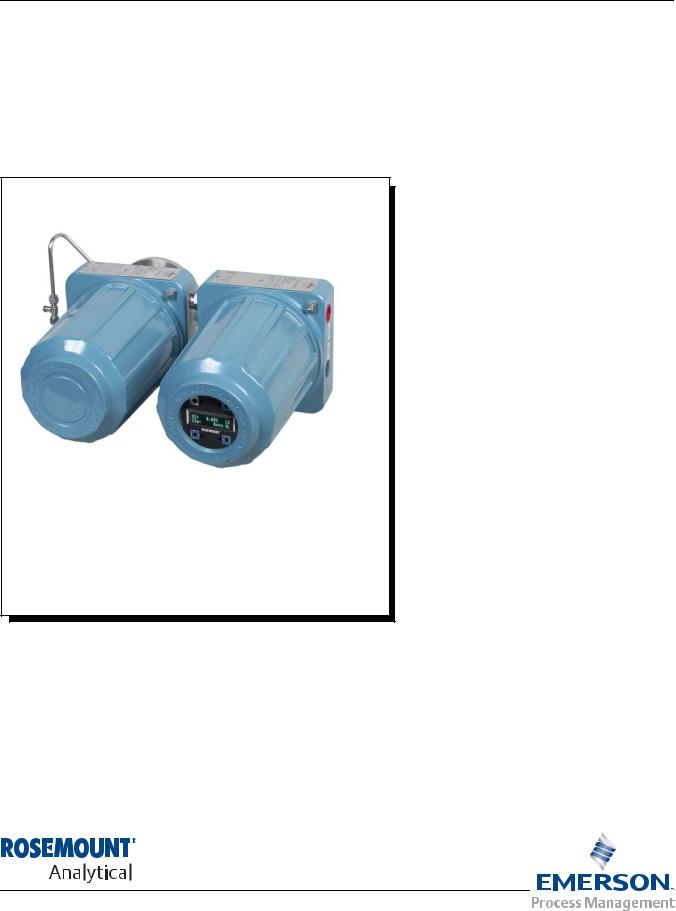
Instruction Manual
IM-106-880, Rev 1.0
January 2007
OCX 8800
Oxygen/Combustibles Transmitter
Hazardous Area OCX 8800 Oxygen/Combustibles Transmitter with Integral Electronics and Local Operator Interface
http://www.raihome.com
|
HIGHLIGHTS OF CHANGES |
|
Effective January, 2007 Rev 1.0 |
|
|
Page |
Summary |
|
|
Page 2-19 |
Revised Figure 2-11. |
Page 3-2 |
Revised the text for SW1 and SW2 to read internally powered. |
Page 3-3 |
Revised Figure 3-1. Updated the paragraph Initial Power Up. |
Page A-2 thru A-23 |
Added note 11 to the safety data section. Added additional pages/languages. |
Page C-1 |
Updated the return of materials address. |
Back cover |
Updated the address blocks. |
|
|
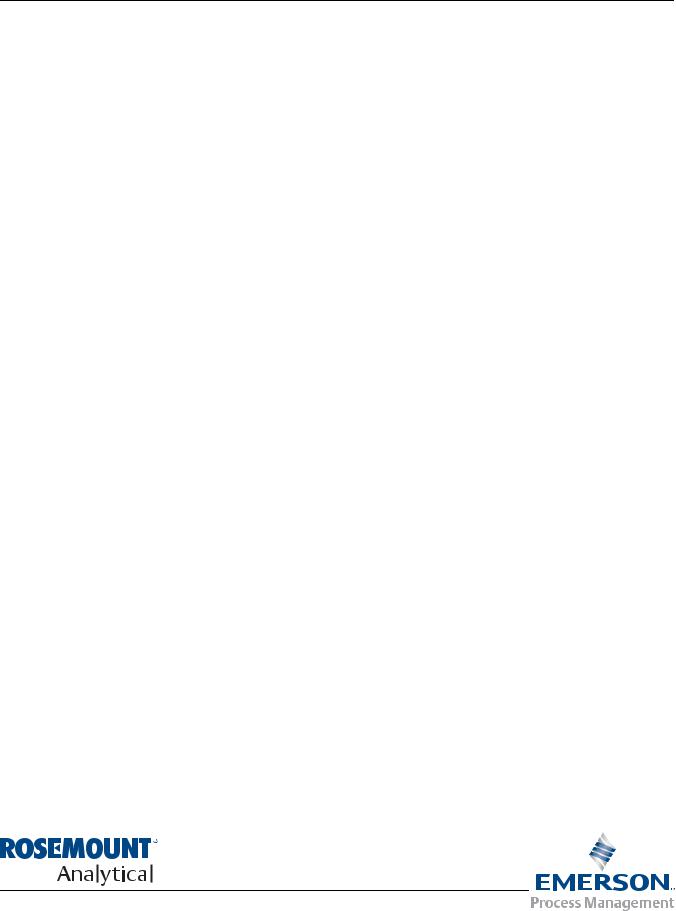
Instruction Manual
IM-106-880, Rev 1.0
January 2007
OCX 8800
Table of Contents
SECTION 1
Description and
Specifications
SECTION 2
Installation
SECTION 3
Configuration and
Startup
SECTION 4
Using the LOI
SECTION 5
Using HART
Communications
SECTION 6
Calibration
Essential Instructions. . . . . . . . . . . . . . . . . . . . . . . . . . . . . . . . . . . . . . . . i
Preface . . . . . . . . . . . . . . . . . . . . . . . . . . . . . . . . . . . . . . . . . . . . . . . . . . ii
Definitions . . . . . . . . . . . . . . . . . . . . . . . . . . . . . . . . . . . . . . . . . . . . . . . . ii
Symbols . . . . . . . . . . . . . . . . . . . . . . . . . . . . . . . . . . . . . . . . . . . . . . . . . . ii
Component Checklist. . . . . . . . . . . . . . . . . . . . . . . . . . . . . . . . . . . . . . 1-1
System Overview. . . . . . . . . . . . . . . . . . . . . . . . . . . . . . . . . . . . . . . . . 1-1
Specifications. . . . . . . . . . . . . . . . . . . . . . . . . . . . . . . . . . . . . . . . . . . . 1-9
Mechanical
Installation . . . . . . . . . . . . . . . . . . . . . . . . . . . . . . . . . . . . . . . . . . . . . . 2-2
Electrical Installation . . . . . . . . . . . . . . . . . . . . . . . . . . . . . . . . . . . . . . 2-7
Pneumatic Installation . . . . . . . . . . . . . . . . . . . . . . . . . . . . . . . . . . . . 2-10
Initial Startup . . . . . . . . . . . . . . . . . . . . . . . . . . . . . . . . . . . . . . . . . . . 2-16
Verify Installation . . . . . . . . . . . . . . . . . . . . . . . . . . . . . . . . . . . . . . . . . 3-1
Initial Power Up . . . . . . . . . . . . . . . . . . . . . . . . . . . . . . . . . . . . . . . . . . 3-3
Set Test Gas Values . . . . . . . . . . . . . . . . . . . . . . . . . . . . . . . . . . . . . . 3-4
OCX 8800 Reset Procedure . . . . . . . . . . . . . . . . . . . . . . . . . . . . . . . . 3-4
Overview . . . . . . . . . . . . . . . . . . . . . . . . . . . . . . . . . . . . . . . . . . . . . . . 4-1
Display Orientation . . . . . . . . . . . . . . . . . . . . . . . . . . . . . . . . . . . . . . . 4-1
LOI Controls. . . . . . . . . . . . . . . . . . . . . . . . . . . . . . . . . . . . . . . . . . . . . 4-2
Overview. . . . . . . . . . . . . . . . . . . . . . . . . . . . . . . . . . . . . . . . . . . . . 4-2
LOI Key Functions . . . . . . . . . . . . . . . . . . . . . . . . . . . . . . . . . . . . . 4-2
LOI Status Codes . . . . . . . . . . . . . . . . . . . . . . . . . . . . . . . . . . . . . . 4-3
LOI Menu Tree. . . . . . . . . . . . . . . . . . . . . . . . . . . . . . . . . . . . . . . . . . . 4-4
D/A Trim Procedures . . . . . . . . . . . . . . . . . . . . . . . . . . . . . . . . . . . . . . 4-8
Overview . . . . . . . . . . . . . . . . . . . . . . . . . . . . . . . . . . . . . . . . . . . . . . . 5-1
HART Communicator Signal Connections. . . . . . . . . . . . . . . . . . . . . . 5-1
HART Communicator PC Connections . . . . . . . . . . . . . . . . . . . . . . . . 5-4
HART Menu Tree. . . . . . . . . . . . . . . . . . . . . . . . . . . . . . . . . . . . . . . . . 5-5
D/A Trim Procedures . . . . . . . . . . . . . . . . . . . . . . . . . . . . . . . . . . . . . . 5-9
Overview . . . . . . . . . . . . . . . . . . . . . . . . . . . . . . . . . . . . . . . . . . . . . . . 6-1
Fully Automatic Calibration . . . . . . . . . . . . . . . . . . . . . . . . . . . . . . . . . 6-1
Operator - Initiated Autocalibration . . . . . . . . . . . . . . . . . . . . . . . . . . . 6-4
Manual Calibration. . . . . . . . . . . . . . . . . . . . . . . . . . . . . . . . . . . . . . . . 6-4
http://www.raihome.com

OCX 8800
Instruction Manual
IM-106-880, Rev 1.0
January 2007
SECTION 7
Maintenance and Service
SECTION 8
Troubleshooting
SECTION 9
Replacement Parts
APPENDIX A
Safety Data
APPENDIX B
SPA with HART Alarm
APPENDIX C
Return of Materials
Overview . . . . . . . . . . . . . . . . . . . . . . . . . . . . . . . . . . . . . . . . . . . . . . . 7-1
OCX 8800 Removal
and Installation. . . . . . . . . . . . . . . . . . . . . . . . . . . . . . . . . . . . . . . . . . . 7-1
OCX with
Integral Electronics . . . . . . . . . . . . . . . . . . . . . . . . . . . . . . . . . . . . . 7-2
Repair Sensor Housing . . . . . . . . . . . . . . . . . . . . . . . . . . . . . . . . . . . . 7-5
Sensor Housing Disassembly. . . . . . . . . . . . . . . . . . . . . . . . . . . . . 7-5
Sensor Housing Assembly . . . . . . . . . . . . . . . . . . . . . . . . . . . . . . 7-15
Repair Electronics Housing . . . . . . . . . . . . . . . . . . . . . . . . . . . . . . . . 7-25
Electronics Housing Disassembly . . . . . . . . . . . . . . . . . . . . . . . . 7-25
Electronics Housing Assembly . . . . . . . . . . . . . . . . . . . . . . . . . . . 7-28
Replace Tube Fittings . . . . . . . . . . . . . . . . . . . . . . . . . . . . . . . . . . . . 7-31
Remove Tube Fittings . . . . . . . . . . . . . . . . . . . . . . . . . . . . . . . . . 7-31
Install Tube Fittings . . . . . . . . . . . . . . . . . . . . . . . . . . . . . . . . . . . 7-32
Overview . . . . . . . . . . . . . . . . . . . . . . . . . . . . . . . . . . . . . . . . . . . . . . . 8-1
Grounding. . . . . . . . . . . . . . . . . . . . . . . . . . . . . . . . . . . . . . . . . . . . 8-1
Electrical Noise. . . . . . . . . . . . . . . . . . . . . . . . . . . . . . . . . . . . . . . . 8-1
Electrostatic Discharge. . . . . . . . . . . . . . . . . . . . . . . . . . . . . . . . . . 8-1
Total Power Loss . . . . . . . . . . . . . . . . . . . . . . . . . . . . . . . . . . . . . . 8-2
Diagnostic Alarms . . . . . . . . . . . . . . . . . . . . . . . . . . . . . . . . . . . . . . . . 8-2
Fault Isolation . . . . . . . . . . . . . . . . . . . . . . . . . . . . . . . . . . . . . . . . . . . 8-3
Alarm Relay Events . . . . . . . . . . . . . . . . . . . . . . . . . . . . . . . . . . . . . . 8-11
Sensor Housing . . . . . . . . . . . . . . . . . . . . . . . . . . . . . . . . . . . . . . . . . . 9-2
Electronics Housing . . . . . . . . . . . . . . . . . . . . . . . . . . . . . . . . . . . . . . . 9-6
O2 Cell and Heater Strut Assembly. . . . . . . . . . . . . . . . . . . . . . . . . . . 9-9
Safety Instructions . . . . . . . . . . . . . . . . . . . . . . . . . . . . . . . . . . . . . . . . A-2 Safety Data Sheet for Ceramic Fiber Products . . . . . . . . . . . . . . . . . A-24 High Pressure Gas Cylinders . . . . . . . . . . . . . . . . . . . . . . . . . . . . . . A-29 Atex Clarification . . . . . . . . . . . . . . . . . . . . . . . . . . . . . . . . . . . . . . . . A-31
Overview . . . . . . . . . . . . . . . . . . . . . . . . . . . . . . . . . . . . . . . . . . . . . . . B-1
Description. . . . . . . . . . . . . . . . . . . . . . . . . . . . . . . . . . . . . . . . . . . . . . B-1
Installation . . . . . . . . . . . . . . . . . . . . . . . . . . . . . . . . . . . . . . . . . . . . . . B-2
Setup . . . . . . . . . . . . . . . . . . . . . . . . . . . . . . . . . . . . . . . . . . . . . . . . . . B-2
Returning Material . . . . . . . . . . . . . . . . . . . . . . . . . . . . . . . . . . . . . . . .C-1
TOC-2
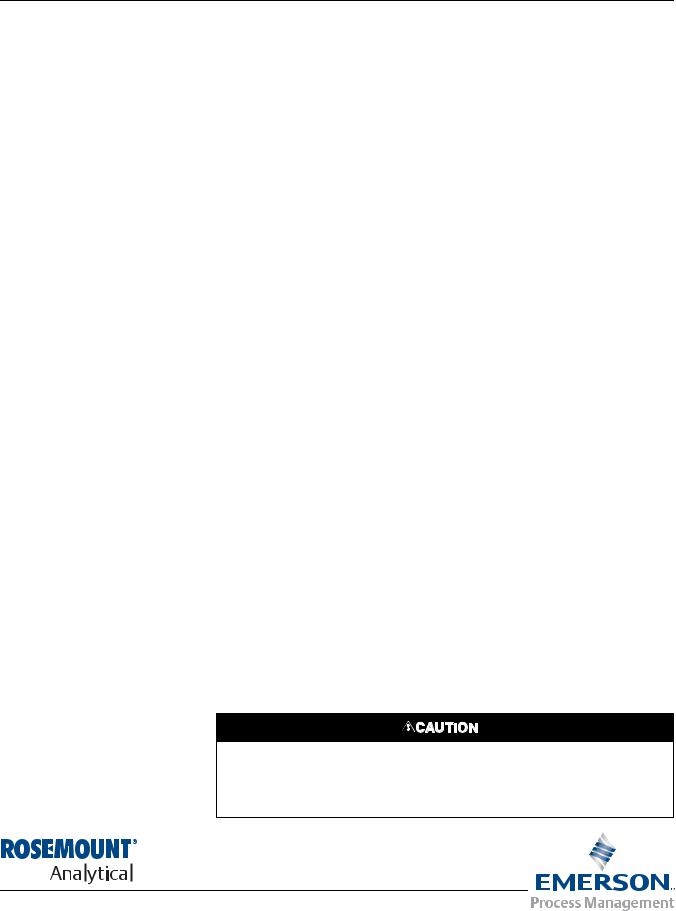
Instruction Manual
IM-106-880, Rev 1.0
January 2007
OCX 8800
ESSENTIAL INSTRUCTIONS
OCX 8800
Oxygen/Combustibles Transmitter
READ THIS PAGE BEFORE PROCEEDING!
Emerson Process Management designs, manufactures and tests its products to meet many national and international standards. Because these instruments are sophisticated technical products, you MUST properly install, use, and maintain them to ensure they continue to operate within their normal specifications. The following instructions MUST be adhered to and integrated into your safety program when installing, using, and maintaining Emerson’s Rosemount Analytical products. Failure to follow the proper instructions may cause any one of the following situations to occur: Loss of life; personal injury; property damage; damage to this instrument; and warranty invalidation.
•Read all instructions prior to installing, operating, and servicing the product.
•If you do not understand any of the instructions, contact your Emerson Process Management representative for clarification.
•Follow all warnings, cautions, and instructions marked on and supplied with the product.
•Inform and educate your personnel in the proper installation, operation, and maintenance of the product.
•Install your equipment as specified in the Installation Instructions of the appropriate Instruction Manual and per applicable local and national codes. Connect all products to the proper electrical and pressure sources.
•To ensure proper performance, use qualified personnel to install, operate, update, program, and maintain the product.
•When replacement parts are required, ensure that qualified people use replacement parts specified by Emerson Process Management. Unauthorized parts and procedures can affect the product's performance, place the safe operation of your process at risk, and VOID YOUR WARRANTY. Look-alike substitutions may result in fire, electrical hazards, or improper operation.
•Ensure that all equipment doors are closed and protective covers are in place, except when maintenance is being performed by qualified persons, to prevent electrical shock and personal injury.
The information contained in this document is subject to change without notice.
If a Model 275/375 Universal HART® Communicator is used with this unit, the software within the Model 275/375 may require modification. If a software modification is required, please contact your local Emerson Process Management Service Group or National Response Center at 1-800-654-7768.
http://www.raihome.com
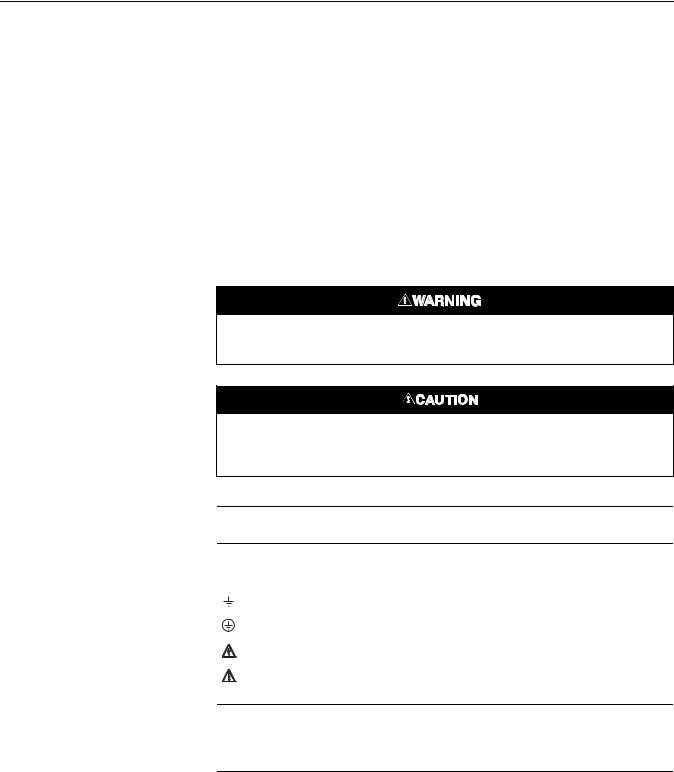
OCX 8800
Instruction Manual
IM-106-880, Rev 1.0
January 2007
PREFACE |
The purpose of this manual is to provide a comprehensive understanding of |
||
|
the OCX 8800 components, functions, installation, and maintenance. |
||
|
We recommend that you thoroughly familiarize yourself with the Introduction |
||
|
and Installation sections before installing your transmitter. |
||
|
The introduction presents the basic principles of the transmitter along with its |
||
|
performance characteristics and components. The remaining sections contain |
||
|
detailed procedures and information necessary to install and service the |
||
|
transmitter. |
||
|
Before contacting Emerson Process Management concerning any questions, |
||
|
first consult this manual. It describes most situations encountered in your |
||
|
equipment's operation and details necessary action. |
||
DEFINITIONS |
The following definitions apply to WARNINGS, CAUTIONS, and NOTES |
||
|
found throughout this publication. |
||
|
|
|
|
|
|
|
|
Highlights an operation or maintenance procedure, practice, condition, statement, etc. If not strictly observed, could result in injury, death, or long-term health hazards of personnel.
Highlights an operation or maintenance procedure, practice, condition, statement, etc. If not strictly observed, could result in damage to or destruction of equipment, or loss of effectiveness.
NOTE
Highlights an essential operating procedure, condition, or statement.
SYMBOLS
: EARTH (GROUND) TERMINAL
: PROTECTIVE CONDUCTOR TERMINAL : RISK OF ELECTRICAL SHOCK
: WARNING: REFER TO INSTRUCTION BULLETIN
NOTE TO USERS
The number in the lower right corner of each illustration in this publication is a manual illustration number. It is not a part number, and is not related to the illustration in any technical manner.
ii
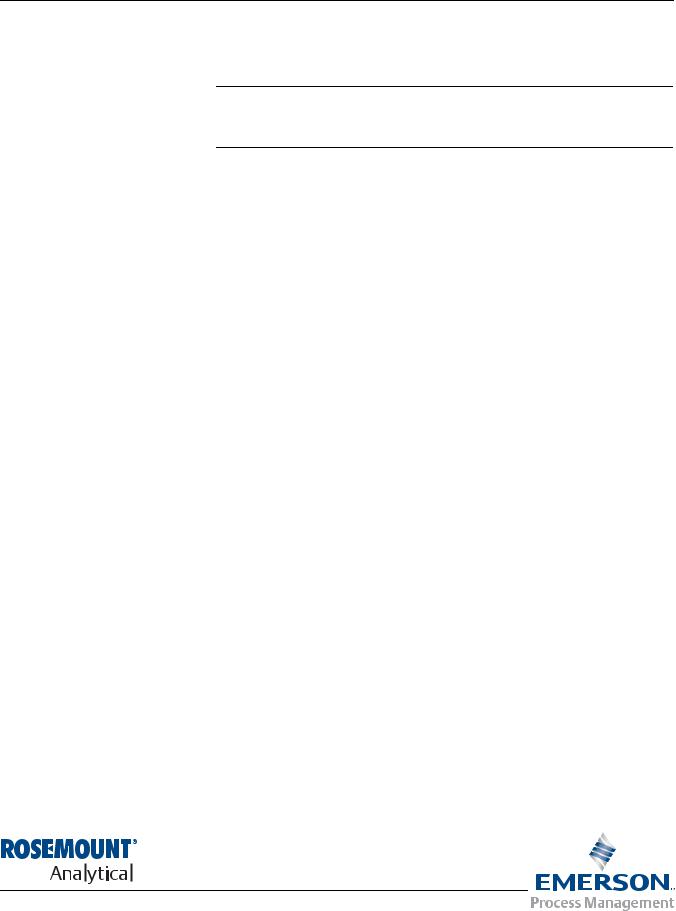
Instruction Manual
IM-106-880, Rev 1.0
January 2007
OCX 8800
Section 1 Description and Specifications
COMPONENT
CHECKLIST
SYSTEM OVERVIEW
Component Checklist . . . . . . . . . . . . . . . . . . . . . . . . . . . . . page 1-1 System Overview . . . . . . . . . . . . . . . . . . . . . . . . . . . . . . . . page 1-1 Specifications . . . . . . . . . . . . . . . . . . . . . . . . . . . . . . . . . . . page 1-9
A typical OCX 8800 Oxygen/Combustibles Transmitter package should contain the items shown in Figure 1-1.
Use the product matrix in Table 1-1 at the end of this section to verify your order number. The first part of the matrix defines the model. The last part defines the various options and features of the OCX 8800. Check the model number against the transmitter features and options, making sure options specified by this number are on or included with the unit. Use this complete model number for any correspondence with Emerson Process Management. A list of accessories for use with the OCX 8800 is provided in Table 1-2.
Scope
This Instruction Manual supplies details needed to install, startup, operate, and maintain the OCX 8800. Signal conditioning electronics outputs separate 4-20 mA signals representing oxygen (O2) and combustibles (COe) values. This information, plus additional details, can be accessed with the HART Model 275/375 handheld communicator or Rosemount Analytical AMS software. The local operator interface (LOI) also provides a communications interface with the electronics.
System Description
The OCX 8800 is designed to measure oxygen and combustible concentrations in flue gas temperatures up to 2600°F (1427°C). Electrical connections, power and communications are made through two 3/4 NPT ports in the flameproof electronics enclosure using fittings and cables provided by the customer. Cable installation must meet NEC, IEC and/or other applicable national or local codes for Class I, Zone 1, Group IIB +H2 T3/T6 permanently mounted equipment. The transmitter is close coupled to the process and requires minimal sample conditioning requirements.
http://www..raihome.com
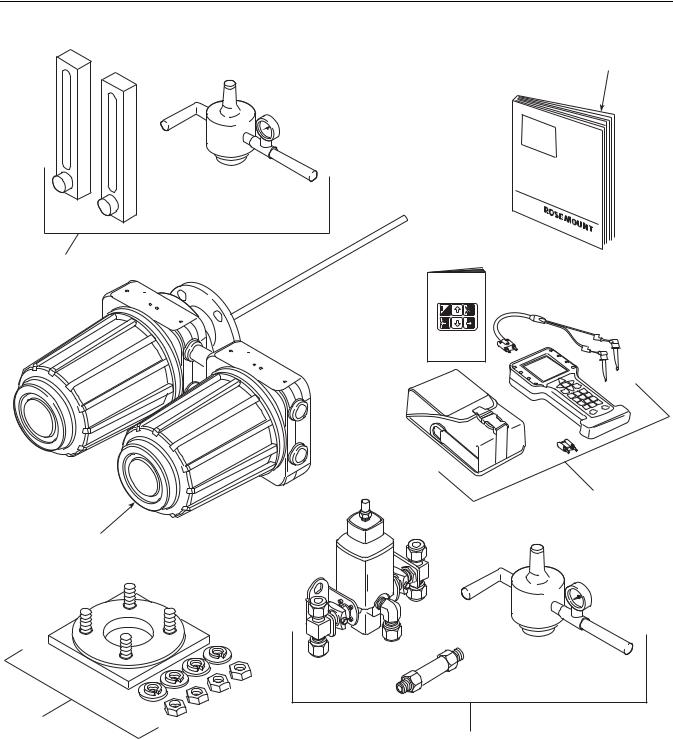
OCX 8800
Instruction Manual
IM-106-880, Rev 1.0
January 2007
Figure 1-1. Typical System Package
1
Analytical
4
MAN 4275A00
English
October 1994
HART Communicator
Communicator
o
FISHER-ROSEMOUNTTM
2
6
3
5
1.Instruction Manual
2.HART®Communicator Package (optional)
3.Adapter Plate with Mounting Hardware and Gasket
4.Reference Air and Calibration Set
5.Blowback Hardware (optional)
6.OCX 8800 with Integral Electronics
37390006
1-2

Instruction Manual
IM-106-880, Rev 1.0
January 2007
OCX 8800
The equipment measures oxygen percentage by reading the voltage developed across a heated electrochemical cell, which consists of a small yttria-stabilized, zirconia disc. Both sides of the disc are coated with porous metal electrodes. When operated at the proper temperature, the millivolt output of the cell is given by the following Nernst equation:
EMF = KT log10 (P1/P2) + C
Where:
1.P2 is the partial pressure of the oxygen in the measured gas on one side of the cell.
2.P1 is the partial pressure of the oxygen in the reference air on the opposite side of the cell.
3.T is the absolute temperature.
4.C is the cell constant.
5.K is an arithmetic constant.
NOTE
For best results, use clean, dry instrument air (20.95% oxygen) as the reference air.
When the cell is at operating temperature and there are unequal oxygen concentrations across the cell, oxygen ions will travel from the high oxygen partial pressure side to the low oxygen partial pressure side of the cell. The resulting logarithmic output voltage is approximately 50 mV per decade. The output is proportional to the inverse logarithm of the oxygen concentration. Therefore, the output signal increases as the oxygen concentration of the sample gas decreases. This characteristic enables the OCX 8800 to provide exceptional sensitivity at low oxygen concentrations.
The OCX 8800 measures net oxygen concentration in the presence of all the products of combustion, including water vapor. Therefore, it may be considered an analysis on a "wet" basis. In comparison with older methods, such as the portable apparatus, which provides an analysis on a "dry" gas basis, the "wet" analysis will, in general, indicate a lower percentage of oxygen. The difference will be proportional to the water content of the sampled gas stream.
The OCX 8800 combustibles sensor is a catalytic sensor consisting of two Resistance Devices (RTD). One RTD is the reference element covered with an inert coating. The other RTD element is active, coated with a catalyst. As the sample gases flow by the sensor, the combustible gases oxidize on the surface of the active element. The oxidation that occurs produces heat and a temperature rise in the active element. The temperature difference produces a resistance relationship between the two elements that is directly proportional to the concentration of combustibles in the sample gases.
1-3

OCX 8800
Instruction Manual
IM-106-880, Rev 1.0
January 2007
The catalyst is specifically designed to detect carbon monoxide (CO), but the sensor responds to other combustible gases. The sensor is calibrated using CO, thus the output should be expressed in terms of CO. However, since the sensor detects other combustible gases, the output cannot just be labeled CO. The response of the sensor to other combustible gases gives an output that is equivalent to the sensor detecting CO. The term COe is used in this manual to describe the sensor output. This term indicates that the sensor is calibrated in terms of CO, and that the sensor output is equivalent to CO but not specific to CO.
Dilution air is provided to the COe sensor to ensure there is adequate oxygen to fully oxidize any combustible gases regardless of the concentration of oxygen in the process.
System Configuration
Transmitters are available in four lengths, giving the user the flexibility to use a penetration appropriate to the size of the stack or duct. The length options are 18 in. (457 mm), 3 ft (0.91 m), 6 ft (1.83 m), or 9 ft (2.7 m). Probes are available in three material options, 316L stainless steel, inconel 600, and ceramic to accommodate higher temperatures.
The electronics are contained in a separate housing from the sensors. The electronics and sensor housings are integrally mounted.
The electronics control both sensor temperatures and provide individual 4-20 mA isolated outputs that are proportional to the measured oxygen and combustibles concentrations. The power supply can accept voltages of 100 to 240 VAC and 50 to 60 Hz. The electronics accepts millivolt signals generated by the sensors and produces the outputs to be used by remotely connected devices. The outputs are isolated 4-20 mA linearized currents. Refer to Section 3, Configuration and Startup for specific instructions upon initial power up.
System Features
1.The O2 cell output voltage and sensitivity increase as the oxygen concentration decreases.
2.HART communication is standard. To use the HART capability, you must have either:
a.HART Model 275/375 Communicator.
b.AMS software for the PC.
3.Oxygen cell and heater/thermocouple assembly are field replaceable.
4.Electronics are automatically configured for line voltages from 100 to 240 VAC.
1-4

Instruction Manual
IM-106-880, Rev 1.0
January 2007
OCX 8800
5.An operator can calibrate and diagnostically troubleshoot the OCX 8800 in one of two ways:
a.LOI. The LOI is mounted to the end of the electronics module and allows local communications with the electronics. Refer to Section 4, Using the LOI, for more information.
b.Optional HART Interface. Each of the OCX 8800's 4-20 mA output lines transmit an analog signal proportional to oxygen or combustible levels detected. The HART output is superimposed on the oxygen 4-20 mA output line only. This information can be accessed through the following:
•Model 275/375 Handheld Communicator - The handheld communicator requires Device Description (DD) software specific to the OCX 8800. The DD software will be supplied with many Model 275/375 units, but can also be programmed into existing units at most Emerson Process Management service offices. Refer to Section 5, Using HART Communications, for additional information.
•Personal Computer (PC) - The use of a personal computer requires AMS software available from Emerson Process Management.
•Selected Distributed Control Systems - The use of distributed control systems requires input/output (I/O) hardware and AMS software which permit HART communications.
6.Optional Blowback System. The blowback system periodically blows instrument air back through the sample line filter and out the sample tube. This clears out particulate and keeps the sample line filter from clogging.
System Operation
Figure 1-2 shows the relationship between the components of the OCX 8800. The sensors and the electronics are contained in separate housings. The sensor housing and probe mounts to a duct or process wall so that the probe protrudes into the flue gas stream. An air powered eductor continuously pulls samples of the process flue gas through the probe to a chamber in front of the sensor housing where the sample passes the O2 sensor and continues on to the COe sensor. Dilution air is provided to the COe sensor and reference air to the O2 sensor. After the gas sample flows past the O2 sensor and through the COe sensor, it is drawn through the eductor where it mixes with the eductor air and exits through exhaust back into the system. The electronics housing contains the CPU and HART boards which convert the sensor inputs into 4-20 mA analog output signals. The CPU can also initiate and perform calibrations. Three test gasses and instrument air can be turned on and off by solenoids. Test gas flow to the sensors is regulated by a flow meter between the electronics and sensor housings. Instrument air is separated into eductor air, reference air, and dilution air. The instrument air solenoid does not allow air flow until the heaters are up to temperature. This minimizes the amount of sampled process flue gas being pulled into cold sensors causing condensation.
1-5
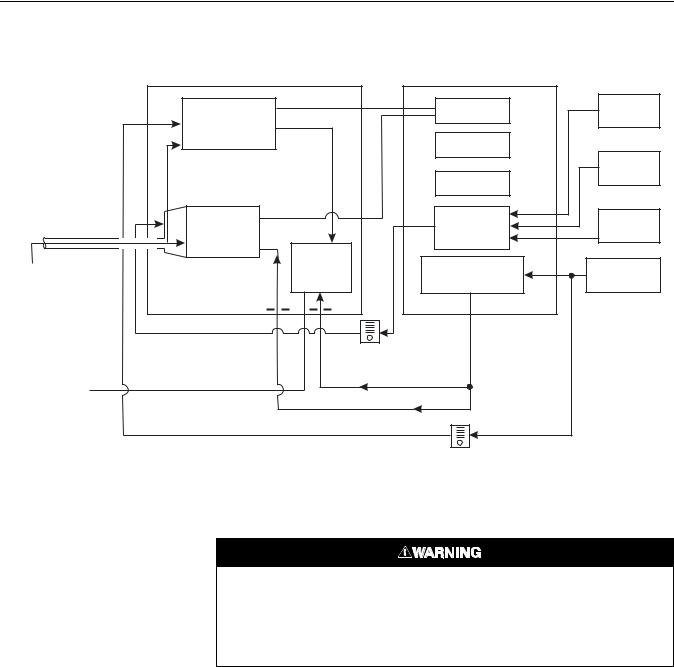
OCX 8800
Instruction Manual
IM-106-880, Rev 1.0
January 2007
Figure 1-2. System Operation Diagram |
|
|
|
SENSOR |
ELECTRONICS |
|
HOUSING |
HOUSING |
|
COe |
CPU |
|
Combustibles |
|
|
Sensor |
HART |
|
|
|
|
|
Board |
|
|
Power |
|
|
Supply |
|
O2 |
Optional |
Probe |
Test Gas |
|
|
Sensor |
Solenoids |
Sample |
Eductor |
Instrument Air |
|
Solenoid |
|
Gas |
|
|
|
|
|
Flow Meter
7 scfh
Eductor Air
Exhaust 
Reference Air
Dilution Air
Flow Meter
50 cc/min.
(0.1 scfh)
Handling the OCX 8800
Low O2
Test Gas
High O2
Test Gas
CO
Test Gas
Instrument
Air
37390001
It is important that printed circuit boards and integrated circuits are handled only when adequate antistatic precautions have been taken to prevent possible equipment damage.
The OCX 8800 is designed for industrial application. Treat each component of the system with care to avoid physical damage. The probe may contain components made from ceramics, which are susceptible to shock when mishandled.
System Considerations
Prior to installing your OCX 8800, make sure you have all the components necessary to make the system installation. Ensure all the components are properly integrated to make the system functional.
1-6
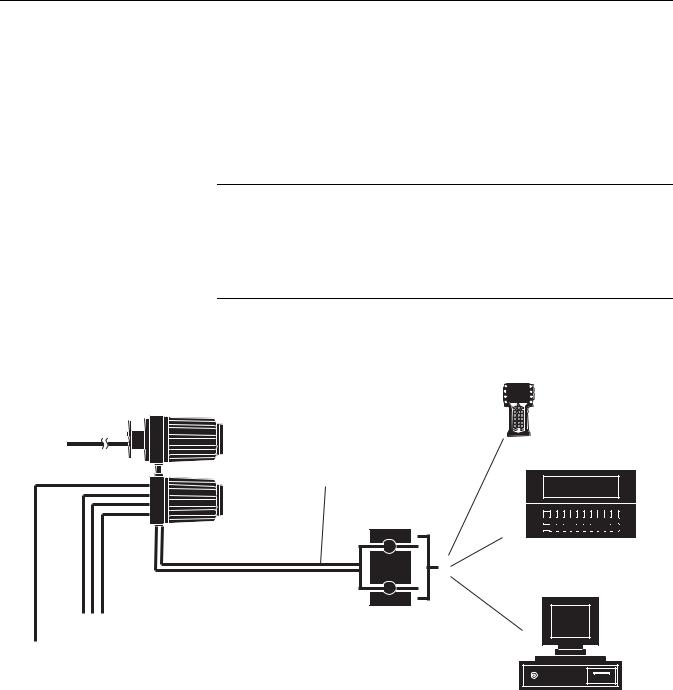
Instruction Manual
IM-106-880, Rev 1.0
January 2007
OCX 8800
After verifying that you have all the components, select mounting locations and determine how each component will be placed in terms of available line voltage, ambient temperatures, environmental considerations, convenience, and serviceability. Figure 1-3 shows a typical system wiring. Simplified installations for the OCX 8800 are shown in Figure 1-4.
A source of instrument air is required at the OCX 8800 for reference air, dilution air, and eductor air. Since the OCX 8800 is equipped with an in-place calibration feature, provision should be made for connecting test gas tanks to the OCX 8800 when it is to be calibrated.
NOTE
The electronics module is designed to meet NEMA 4 (IP66) and the electronic components are rated to temperatures up to 185°F (85°C).
Retain packaging in which the unit arrived from the factory in case any components are to be shipped to another site. This packaging has been designed to protect the product.
Figure 1-3. OCX 8800 HART
Connections and AMS Application
OCX 8800 with
Integral Electronics
|
3 calibration |
|
gas lines by |
Instrument |
customer |
Air |
[300 ft (91 m) max.) |
HART
Model 275/375
Handheld
Communicator
4-20 mA Output
(Twisted Pairs)
Customer’s Laptop
with AMS
Termination in
Control Room
AMS
37390002
1-7
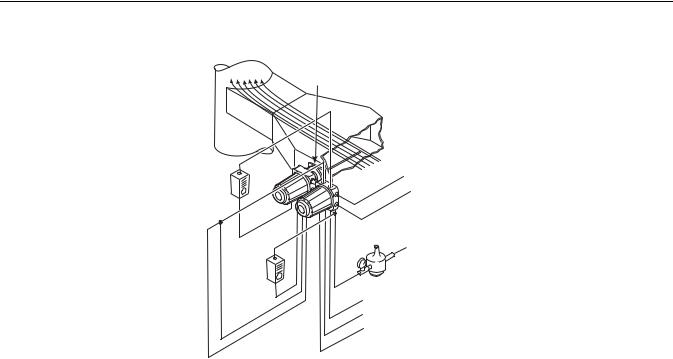
OCX 8800
Instruction Manual
IM-106-880, Rev 1.0
January 2007
Figure 1-4. Typical System
Installation
Gases |
Adapter |
OCX 8800 with |
|
|
Plate |
INTEGRAL |
|
|
|
ELECTRONICS |
|
|
Duct |
|
|
Stack |
|
|
|
|
|
4-20 mA Outputs |
|
Test Gas |
|
(2 Twisted Pairs) |
|
|
|
|
|
Flow Meter |
|
Line Voltage |
|
|
Pressure |
Instrument Air |
|
|
Supply |
|
|
Dilution |
Regulator |
(Reference Gas) |
|
|
|
|
|
Air |
|
|
|
Flow |
|
|
|
Meter |
|
|
|
|
High O2 Test Gas |
|
|
|
Low O2 Test Gas |
37390063 |
|
|
CO Test Gas |
||
|
|
||
1-8

Instruction Manual
IM-106-880, Rev 1.0
January 2007
OCX 8800
SPECIFICATIONS
Hazardous Area OCX
Specifications |
|
Net O2 Range |
0-1% to 0-40% O2, fully field selectable |
Combustibles |
0-1000 ppm to 0-5%, fully field selectable |
Accuracy |
|
Oxygen |
± 0.75% of reading or 0.05% O2 (whichever is greater) |
Combustibles |
± 2% range |
|
|
System Response to |
|
Test Gas |
|
Oxygen |
10 sec T90 |
Combustibles |
25 sec T90 |
Temperature Limits |
|
Process |
32° to 2600°F (0° to 1427°C) |
Sensors Housing |
-40° to 212°F (-40° to 100°C), ambient |
Electronics Housing |
-40° to 149°F (-40° to 65°C), ambient |
|
-40° to 185°F (-40° to 85°C), internal - operating temperature of |
|
electronics inside instrument housing, as measured by a HART |
|
communicator or AMS software |
Local Operator |
-40° to 158°F (-40° to 70°C), ambient |
Interface |
[At temperatures above 158°F (70°C) inside instrument housing, |
|
the infrared keypad will cease to function, but the OCX 8800 will |
|
continue to operate properly.] |
Nominal and Approximate |
|
Shipping Weights |
|
18 in. (457 mm) |
54 lbs (20 kg) |
probe package |
|
3 ft (0.91 m) probe |
55 lbs (20.5 kg) |
package |
|
6 ft (1.83 m) probe |
57 lbs (21 kg) |
package |
|
9 ft (2.74 m) probe package
Housings Mounting
Materials
Probes
Enclosures
Calibration
Calibration Gas Mixtures
Recommended
(Ref. test gas bottles
kit #1A99119G04)
Calibration Gas Flow
Reference Air
Eductor Air
Dilution Air
Blowback Air (optional)
59 lbs (22 kg)
Flange
316L stainless steel - 1300°F (704°C) Inconel 600 - 1832°F (1000°C) Ceramic - 2600°F (1427°C)
Low-copper aluminum Semi-automatic or automatic
0.4% O2, Balance N2
8% O2, Balance N2
1000 ppm CO, Balance Air
7 scfh (3.3 l/m)
2 scfh (1 l/m), clean, dry instrument-quality air (20.95% O2), regulated to 45 psi (310 kPa)
5 scfh (2.5 l/m), clean, dry, instrument-quality air 20.95% O2), regulated to 45 psi (310 kPa)
0.1 scfh (0.5 l/m), clean, dry, instrument-quality air (20.95% O2) regulated to 45 psi (310 kPa)
Clean, dry, instrument-quality air (20.95% O2), regulated to 55 psi (379 kPa)
Table continued on next page
1-9
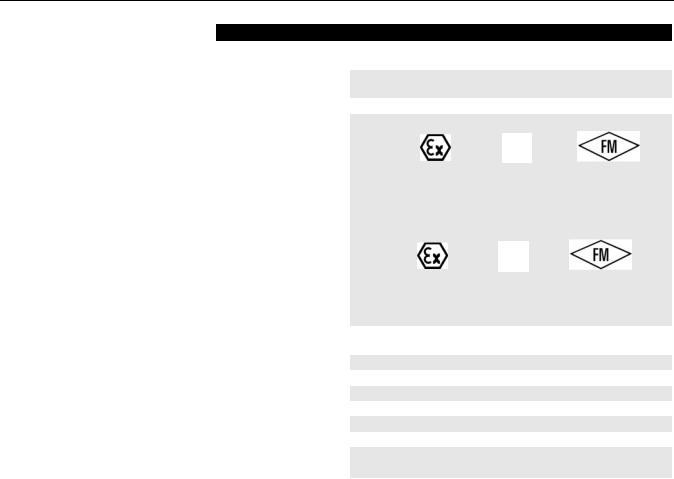
OCX 8800
Instruction Manual
IM-106-880, Rev 1.0
January 2007
Specifications |
|
|
|
|
|
|
|
|
|
|
|
Sensors Housing |
NEMA 4, IP66 with fitting and pipe on reference exhaust port to |
||||||||||
|
clean, dry atmosphere, two 3/4-14 NPT conduit ports |
||||||||||
Electronics Housing |
NEMA 4, IP66 with fitting and pipe on reference exhaust port to |
||||||||||
|
clean, dry atmosphere, two 3/4-14 NPT conduit ports |
||||||||||
Electrical Noise |
EN 61326-1, Class A |
|
|
|
|
|
|
||||
Certifications |
Sensor Housing |
|
|
|
|
|
|
||||
|
|
|
|
|
|
|
|
|
|
|
|
|
|
|
|
0344 |
II 2 G |
|
C |
|
US |
|
|
|
|
|
|
|
|
|
|
APPROVED |
|||
|
|
|
KEMA 04 |
ATEX 2308 |
2005.1602514 |
||||||
|
|
|
|
|
|||||||
|
|
|
CLASS 1, ZONE 1 |
CLASS 1, ZONE 1 |
|||||||
|
|
|
EEx d |
IIB+H2 T3 |
|||||||
|
|
|
|
|
|
Ex d IIB+H2 T3 |
AEx D IIB+H2 T3 |
||||
|
|
|
|
|
|
AEx D IIB+H2 T3 |
TYPE 4 / IP66 |
||||
|
|
|
|
|
|
TYPE 4 / IP66 |
|
|
|||
|
|
|
|
|
|
|
|
|
|
|
|
|
Electronics Housing |
|
|
|
|
|
|
||||
|
|
|
|
|
|
|
|
|
|
|
|
|
|
|
0344 |
II 2 G |
C |
US |
APPROVED |
|
|||
|
|
|
|
|
|
|
|||||
|
|
|
KEMA 04 |
ATEX 2308 |
2005.1602514 |
|
|||||
|
|
|
|
|
|||||||
|
|
|
CLASS 1, ZONE 1 |
CLASS 1, ZONE 1 |
|
||||||
|
|
|
EEx d IIB+H2 T6 IP66 |
|
|||||||
|
|
|
Ex d IIB+H2 T6 |
AEx D IIB+H2 T3 |
|
||||||
|
|
|
|
|
|
|
|||||
|
|
|
|
|
|
AEx D IIB+H2 T6 |
TYPE 4 / IP66 |
|
|||
|
|
|
|
|
|
TYPE 4 / IP66 |
|
|
|||
|
|
|
|
|
|
|
|||||
Line Voltage |
Universal 100 to 240 VAC ±10%, 50 to 60 Hz, no switches or |
||||||||||
|
jumpers required, 3/4-14 NPT conduit port |
|
|
||||||||
Pollution Degree |
2 |
|
|
|
|
|
|
|
|
||
Over Voltage Category |
II |
|
|
|
|
|
|
|
|||
Relative Humidity |
5 to 95% (non-condensing) |
|
|
|
|
||||||
Isolated Output |
|
|
|
|
|
|
|
|
|
|
|
Oxygen |
4-20 mAdc, 950 ohm maximum, with HART capability |
||||||||||
Combustibles |
4-20 mAdc, 950 ohm maximum |
|
|
|
|
||||||
Alarm |
Alarm output relay - dry contact, form C, 30 mA, 30VDC capacity |
||||||||||
Power Consumption |
750 W maximum |
|
|
|
|
|
|
||||
NOTE
All static performance characteristics are with operating variables constant. Specifications subject to change without notice.
1-10

Instruction Manual
IM-106-880, Rev 1.0
January 2007
Table 1-1. Product Matrix - Hazardous Area OCX 8800
OCX 8800
OCX88C |
|
O2/Combustibles Transmitter - Flameproof |
|
|
|
|
|
|
Code |
Probe Length and Material |
|
|
00 |
No Probe or Exhaust Tube |
|
|
11 |
18 in. (457 mm) 316 SST |
up to 1300°F (704°C) |
|
21 |
18 in. (457 mm) Inconel 600 |
up to 2600°F (1427°C) |
|
31 |
18 in. (457 mm) Ceramic |
up to 2600°F (1427°C) |
|
12 |
3 ft (0.91 m) 316 SST |
up to 1300°F (704°C) |
|
22 |
3 ft (0.91 m) Inconel 600 |
up to 1832°F (1000°C) |
|
32 |
3 ft (0.91 m) Ceramic |
up to 2600°F (1427°C) |
|
13 |
6 ft (1.83 m) 316 SST |
up to 1300°F (704°C) |
|
23 |
6 ft (1.83 m) Inconel 600 |
up to 1832°F (1000°C) |
|
14 |
9 ft (2.7 m) 316 SST |
up to 1300°F (704°C) |
|
24 |
9 ft (2.7 m) Inconel 600 |
up to 1832°F (1000°C) |
|
|
Code |
Probe Mounting Assembly |
|
|
|
|
|||||||||
|
|
10 |
(ANSI 2 in. 150 lb) 6" dia. flange, 4.75" BC with 4 x 0.75" dia. holes |
|||||||||||||
|
|
20 |
(DIN) 185 mm dia. flange, 145 mm BC with 4 x 18 mm dia. holes |
|||||||||||||
|
|
|
|
|
|
|
||||||||||
|
|
|
|
Code |
Mounting Hardware - Stack Side |
|
||||||||||
|
|
|
|
0 |
No Adapter Plate (“0” must be chosen under “Mounting Adapter - Probe Side” below) |
|||||||||||
|
|
|
|
1 |
New Installation - Square weld plate with studs |
|||||||||||
|
|
|
|
2 |
Model 218/240 Mounting Plate (with Model 218/240 Shield Removed) |
|||||||||||
|
|
|
|
3 |
Existing Model 218/240 Support Shield |
|||||||||||
|
|
|
|
4 |
Special Mounting (1) |
|
|
|
|
|||||||
|
|
|
|
5 |
Model 132 Adapter Plate |
|
|
|
|
|||||||
|
|
|
|
|
|
|
|
|||||||||
|
|
|
|
|
|
Code |
Mounting Hardware - Probe Side |
|||||||||
|
|
|
|
|
|
0 |
No Adapter Plate |
|
|
|
|
|||||
|
|
|
|
|
|
1 |
Probe Only (ANSI) |
|
||||||||
|
|
|
|
|
|
2 |
Probe Only (DIN) |
|
|
|
|
|||||
|
|
|
|
|
|
|
|
|
|
|||||||
|
|
|
|
|
|
|
|
Code |
Electronics Housing - Communications |
|||||||
|
|
|
|
|
|
|
|
H1 |
HART Communications(2) |
|||||||
|
|
|
|
|
|
|
|
H2 |
HART Communications with LOI |
|||||||
|
|
|
|
|
|
|
|
H3 |
HART Communications with Calibration Solenoids(2) |
|||||||
|
|
|
|
|
|
|
|
H4 |
HART Communications with LOI and Calibration Solenoids |
|||||||
|
|
|
|
|
|
|
|
|
|
|
|
|
||||
|
|
|
|
|
|
|
|
|
|
Code |
|
Electronics Mounting |
||||
|
|
|
|
|
|
|
|
|
|
02 |
|
Remote Electronics and no cable |
||||
|
|
|
|
|
|
|
|
|
|
|
|
|
|
|
|
|
|
|
|
|
|
|
|
|
|
|
|
|
|
Code |
|
Accessories |
|
|
|
|
|
|
|
|
|
|
|
|
|
|
00 |
|
None |
|
|
|
|
|
|
|
|
|
|
|
|
|
|
01 |
|
Flow meters & Ref. Air Set |
|
|
|
|
|
|
|
|
|
|
|
|
|
|
02 |
|
In-Situ Filter (Stainless Steel only) |
|
|
|
|
|
|
|
|
|
|
|
|
|
|
03 |
|
In-Situ Filter (SST), Flow meters & Ref. Air Set |
|
|
|
|
|
|
|
|
|
|
|
|
|
|
11 |
|
Flow meters, and Ref. Air Set with Blowback |
|
|
|
|
|
|
|
|
|
|
|
|
|
|
12 |
|
In-Situ Filter (SST) with Blowback |
|
|
|
|
|
|
|
|
|
|
|
|
|
|
13 |
|
In-Situ Filter (SST), Flow meters & Ref. Air Set with Blowback |
|
|
|
|
|
|
|
|
|
|
|
|
|
|
|
|
|
|
OCX88C |
11 |
10 |
1 |
1 |
H2 |
02 |
|
02 |
|
Example |
||||||
NOTES: |
|
|
|
|
|
|
|
|
|
|
|
|
|
|
|
|
(1) Provide details of the existing mounting plate as follows: |
|
|
|
|
|
|
|
|||||||||
Plate with studs |
|
Bolt circle diameter, number, and arrangement of studs, stud thread, stud height above mounting plate. |
||||||||||||||
Plate without studs |
|
Bolt circle diameter, number, and arrangement of holes, thread, depth of stud mounting plate with accessories. |
||||||||||||||
(2)If the LOI is not implemented, remote access and functionality available via HART Communications (Model 275/375 Handheld Communicator) with Oxygen/Combustibles Device Description (DD) required.
1-11

OCX 8800
Instruction Manual
IM-106-880, Rev 1.0
January 2007
Table 1-2. Accessories
PART NUMBER |
DESCRIPTION |
|
1A99119H01 |
Oxygen test gas bottle; 0.4% O2, balance N2 |
|
1A99119H02 |
Oxygen test gas bottle; 8.0% O2, balance N2 |
|
1A 99119H07 |
CO test gas bottle; 1000 ppm CO, balance air |
|
|
|
|
1A99120H02 |
Regulator for Oxygen (may need 2) |
|
1A99120H03 |
Regulator for CO test gas |
|
|
|
|
1A99119G06 |
Wall mount bracket for test gas bottles |
|
1A99119G05 |
Test gas regulators kit |
|
|
|
|
1A99119G04 |
Test gas bottles kit |
|
1A99292H01 |
Moore Industries SPA for Low O2 Alarm, High COe Alarm, |
|
|
Calibration Status, and Unit Fail |
|
1A99339H03 |
Blowback valve, air operated |
|
4851B40G01 |
Wall or Pipe Mounting Kit |
|
|
|
|
1A99784H02 |
375 HART Communicator with 12 Megabyte buffer, |
|
model no. 375HR1EKLU |
||
|
||
6A00171G01 |
Power line filter kit |
1-12
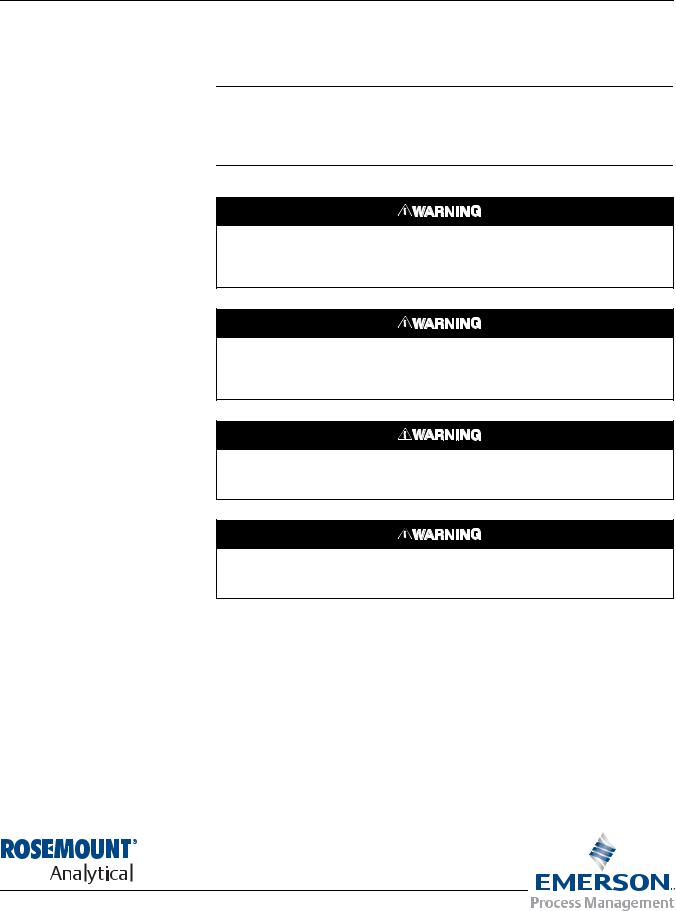
Instruction Manual
IM-106-880, Rev 1.0
January 2007
OCX 8800
Section 2 |
Installation |
Mechanical Installation . . . . . . . . . . . . . . . . . . . . . . . . . . . page 2-2
Electrical Installation . . . . . . . . . . . . . . . . . . . . . . . . . . . . . page 2-7
Pneumatic Installation . . . . . . . . . . . . . . . . . . . . . . . . . . . . page 2-10
Initial Startup . . . . . . . . . . . . . . . . . . . . . . . . . . . . . . . . . . . . page 2-16
Before installing this equipment, read the "Safety instructions for the wiring and installation of this apparatus" in Appendix A: Safety Data. Failure to follow the safety instructions could result in serious injury or death.
To maintain explosion-proof protection of the OCX 8800 in hazardous areas, all cable entry devices and blanking elements for unused apertures must be certified flameproof, suitable for the conditions of use and properly installed.
To maintain explosion-proof protection of the OCX88C in hazardous areas, the sensor housing must not be mounted to any surface or flange that exceeds 200ºC (392ºF).
To maintain explosion-proof protection of the OCX88C in hazardous areas, the sample entering the sensor housing must not exceed 200ºC (392ºF).
http://www..raihome.com
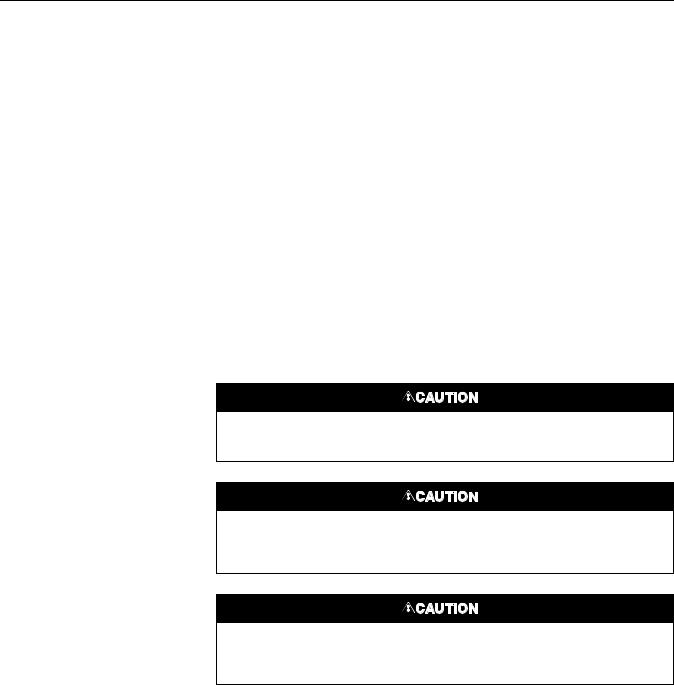
OCX 8800
Instruction Manual
IM-106-880, Rev 1.0
January 2007
MECHANICAL INSTALLATION
Selecting Location
1.The location of the OCX 8800 in the stack or flue is most important for maximum accuracy in the oxygen analyzing process. The probe must be positioned so the gas it measures is representative of the process. Best results are normally obtained if the transmitter is positioned near the center of the duct (40-60% insertion). Longer ducts may require several transmitters since the oxygen and combustibles can vary due to stratification. A point too near the wall of the duct or the inside radius of a bend, may not provide a representative sample because of the very low flow conditions. The sensing point should be selected so the process gas temperature falls within the range of probe material used. Figure 2-1 through Figure 2-3 provide mechanical installation references. The ambient temperature inside the electronics housing must not exceed 185°F (85°C).
2.Check the flue or stack for holes and air leakage. The presence of this condition will substantially affect the accuracy of the oxygen and combustibles readings. Therefore, either make the necessary repairs or install the transmitter up stream of any leakage.
3.Ensure the area is clear of internal and external obstructions that will interfere with installation and maintenance access to the unit. Allow adequate clearance for the removal of the OCX 8800.
Do not allow the temperature of the electronics housing to exceed 185°F (85°C) or damage to the electronics may result.
Whenever a positive stack pressure exists at the installation site, be sure to connect all pneumatic lines prior to installing the OCX 8800 in the stack or ductwork. Failure to connect the pneumatic lines can allow the flow of contaminants into the OCX 8800 ports.
Before installing the OCX 8800 into a hot stack or ductwork, make sure that the OCX 8800 is turned on and at normal operating temperature. Exposing a cold OCX transmitter to hot process gases can cause permanent damage to the equipment.
Installation
1.Ensure all components are available to install the OCX 8800.
2.The OCX 8800 may be installed intact as it is received.
3.Weld or bolt adapter plate (Figure 2-2) onto the duct.
2-2
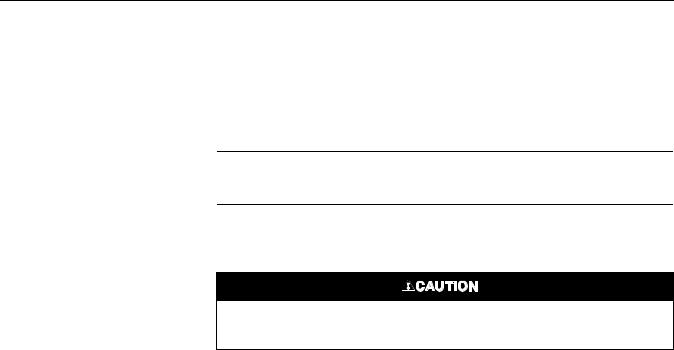
Instruction Manual
IM-106-880, Rev 1.0
January 2007
OCX 8800
4.Ensure the conduits drop vertically from the OCX 8800 and the conduit is routed below the level of the conduit ports on the housing to form a drip loop. Drip loops minimize the possibility that moisture will damage the electronics (Figure 2-3).
5.Where a positive stack pressure exists at the installation site, connect all pneumatic lines prior to installing the OCX 8800 in the stack or ductwork.
NOTE
If process temperatures will exceed 392°F (200°C), use anti-seize compound on stud threads to ease future removal of the OCX 8800.
6.Insert sample and exhaust tubes through the opening in the mounting flange and bolt the unit to the flange.
Uninsulated stacks or ducts may cause ambient temperatures in the electronics housing to exceed 185°F (85°C) and damage the electronics.
7.If insulation is removed to access the duct for OCX 8800 mounting, make sure to replace insulation afterward.
Enclosures
The OCX 8800 enclosures are designed to meet ingress conditions of IP66. Each enclosure cover is threaded to its base and sealed with an o-ring that isolates the threads from external contaminants.
Each cover is secured by a clip attached to the base that engages the cover between the ribs of the cover sidewall. The clip is held in place by an Allen head cap screw and lockwasher mounted in a recess. Cover removal and installation requires an Allen wrench to loosen and tighten the screw.
2-3
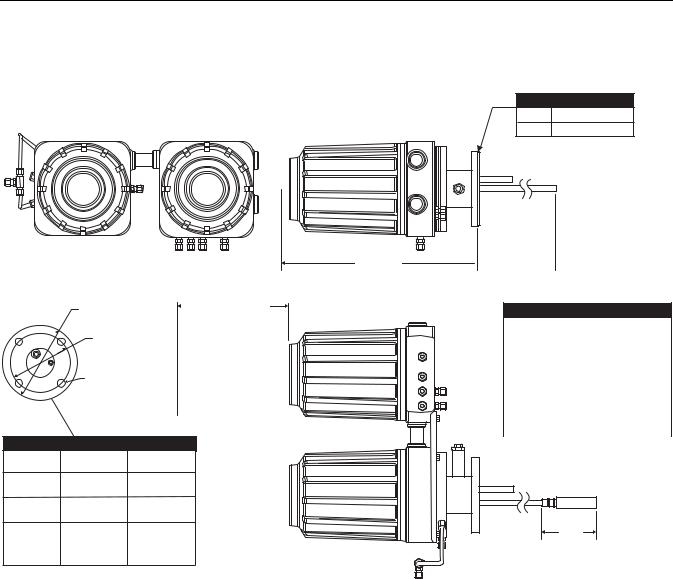
OCX 8800
Figure 2-1. Installation, OCX 8800
NOTE
All dimensions are in inches with millimeters in parentheses.
Insulate if exposed to adverse weather or extreme temperature changes, install a protective housing and/or insulation around the unit.
Dim “B”
Removal Envelope
Allow 9 in.
Flange Dia. |
|
(229 mm) for |
|
Cover Removal
B.C. Dia.
Hole Dia.
Table 1. Mounting Flange
|
ANSI |
DIN |
|
5R10244H01 5R10244H02 |
|
Flange |
6.00 |
7.28 |
Dia. |
(152) |
(185) |
Hole |
0.75 |
0.71 |
Dia. |
(19) |
(18) |
(4) Holes |
4.75 |
5.71 |
equally |
||
spaced on |
(121) |
(145) |
B.C. dia
BOTTOM VIEW
Instruction Manual
IM-106-880, Rev 1.0
January 2007
0.06 In. Thick Gasket
ANSI 3535B18H02
DIN 3535B45H01

 Dim “A”
Dim “A”
Insertion Depth
Table 2. Installation/Removal
Probe |
Dim “A” |
Dim “B” |
|
|
|
|
|
18 in. |
18 |
34 |
|
(457) |
(864) |
||
|
|||
3 ft |
36 |
52 |
|
(914) |
(1321) |
||
|
|||
6 ft |
72 |
88 |
|
(1829) |
(2235) |
||
|
|||
9 ft |
108 |
124 |
|
(2743) |
(3150) |
||
|
Optional
In Situ Filter
8.3 |
|
(211) |
37390008 |
|
2-4
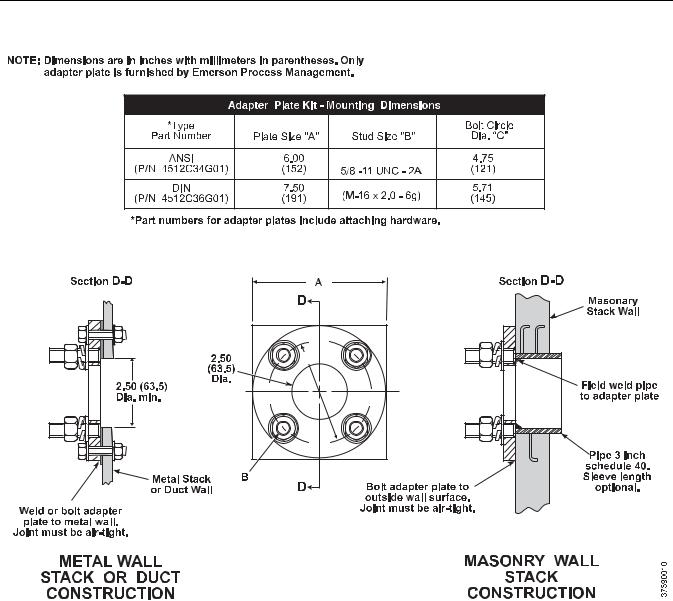
Instruction Manual
IM-106-880, Rev 1.0
January 2007
Figure 2-2. Adapter Plate Installation
OCX 8800
2-5

OCX 8800
Instruction Manual
IM-106-880, Rev 1.0
January 2007
Figure 2-3. Installation with Drip Loops
Conduit Drip Loops |
Duct Wall |
Conduit Drip Loop |
Conduit Drip Loop |
|
Duct Wall |
37020004
2-6
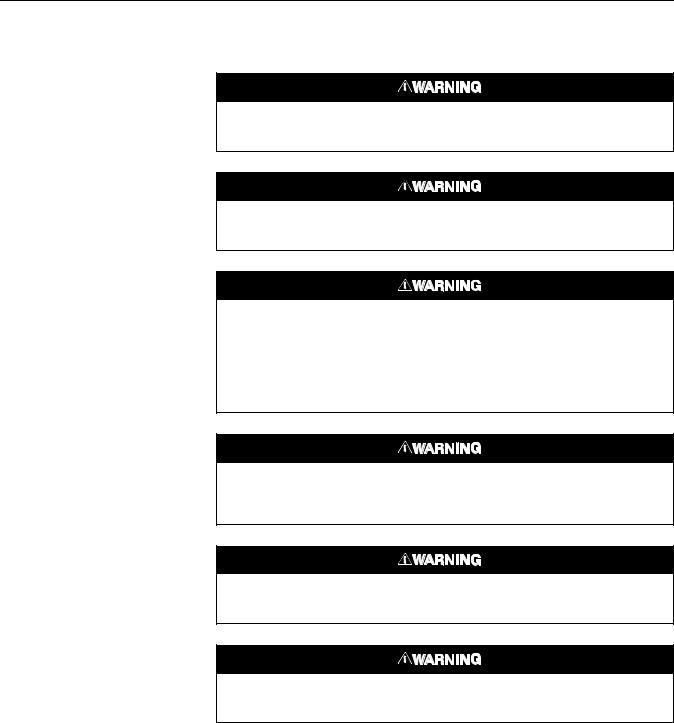
Instruction Manual
IM-106-880, Rev 1.0
January 2007
OCX 8800
ELECTRICAL |
All wiring must conform to local and national codes. For reference, factory |
||
INSTALLATION |
wired solenoid power connections are shown in Figure 2-4. |
||
|
|
|
|
|
|
|
|
Disconnect and lock out power before connecting the unit to the power supply. Failure to lock out power could result in serious injury or death.
Install all protective equipment covers and safety ground leads after installation. Failure to install covers and ground leads could result in serious injury or death.
To meet the Safety Requirements of IEC 1010 (EC requirement), and ensure safe operation of this equipment, connection to the main electrical power supply must be made through a circuit breaker (min 10 A) in close proximity and marked for this equipment which will disconnect all current-carrying conductors during a fault situation. This circuit breaker should also include a mechanically operated isolating switch. If not, then another external means of disconnecting the supply from the equipment should be located close by. Circuit breakers or switches must comply with a recognized standard such as IEC 947.
To maintain explosion-proof protection of the OCX 8800 in hazardous areas, all cable entry devices and blanking elements for unused apertures must be certified flameproof, suitable for the conditions of use and properly installed.
To maintain explosion-proof protection of the OCX88C in hazardous areas, the sensor housing must not be mounted to any surface or flange that exceeds 200ºC (392ºF).
To maintain explosion-proof protection of the OCX88C in hazardous areas, the sample entering the sensor housing must not exceed 200ºC (392ºF).
2-7

OCX 8800
Instruction Manual
IM-106-880, Rev 1.0
January 2007
NOTE
To maintain proper earth grounding, ensure a positive connection exists between the sensor housing, the electronics housing, and earth. The connecting ground wire must be 14 AWG minimum. Refer to Figure 2-4.
NOTE
Line voltage, signal, and relay wiring must be rated for at least 105ºC (221ºF).
Electrical Connections
Electrical connections, power and communications are made to the electronic enclosure. The connections are made through two 3/4 NPT ports in the enclosure using fittings and cables provided by the customer. Cable installation must meet NEC, IEC and/or other applicable national or local codes for Class I, Zone 1, IIB +H2 T3/T6 permanently mounted equipment.
Connect Line Voltage
The OCX 8800 operates on 100 to 240 VAC line voltage at 50 to 60 Hz. The power supply requires no setup. Connect the line (L wire) to the L terminal, and the neutral (N wire) to the N terminal on the AC power input terminal block in the electronics housing. Connect the ground (G wire) to the ground stud in the electronics housing as shown in Figure 2-4.
Connect 4-20 mA Signals
Connect the 4-20 mA current loop to the 4-20 mA signal output terminals in the electronics housing as shown in Figure 2-4. Use individual shielded twisted wire pairs. Terminate the shield at the electronics housing.
O2 4-20 mA Signal
One 4-20 mA signal represents the O2 value. Superimposed on the O2 signal is the HART information accessible through a Model 275/375 Handheld Communicator or AMS software. The O2 signal is at the AOUT 1 terminals.
COe 4-20 mA Signal
Another 4-20 mA signal at the AOUT 2 terminals represents the COe value. HART information is not available on the COe signal.
Alarm Output Relay
Connect any customer-supplied relay input to the alarm output relay terminal. Use shielded wire and terminate the shield at the electronics housing. The alarm output relay terminal is a set of dry, no. 2, form C, contacts with 30 mA, 30 VDC capacity.
2-8
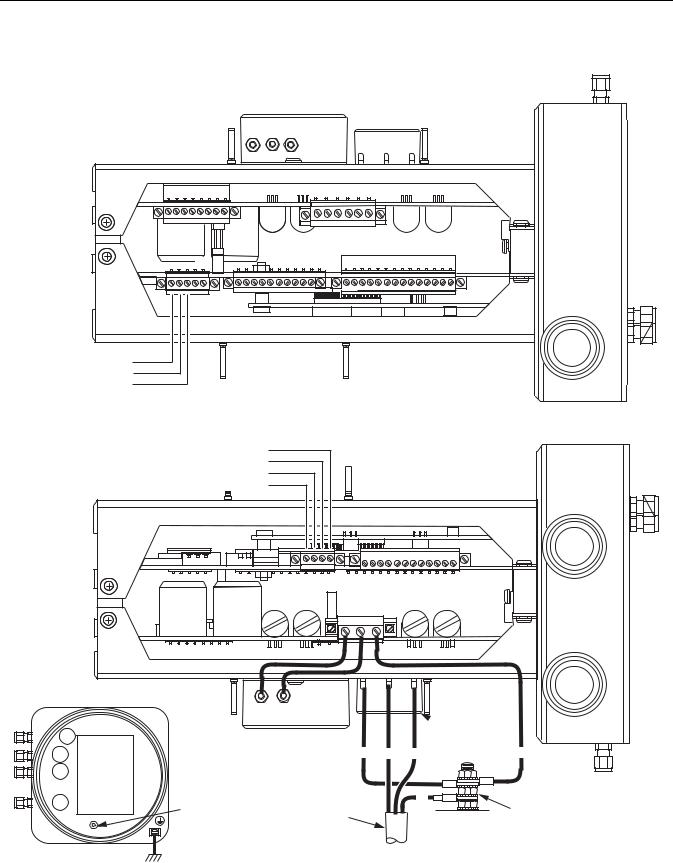
Instruction Manual
IM-106-880, Rev 1.0
January 2007
Figure 2-4. Line Voltage, Earth,
and 4-20 mA Connections
OCX 8800
#1
NC
COM
NO
Alarm Output Relay
Terminal Block
4-20 mA Signal Output
Terminal Block
COe Signal { AOUT2+
AOUT2 -
O2 Signal { AOUT1 -
AOUT1+
#1
EMI Filter
 Terminal
Terminal
Block
G |
N |
L1 |
TOP VIEW |
|
|
(1/2 SIZE) |
|
|
Ground Stud |
Customer |
G |
|
Wiring |
Ground |
||
|
|||
Earth Ground |
|
||
|
Stud |
Typical for Electronics and
Sensor Housing
Signal Port
3/4 NPT
Power Port
3/4 NPT
G
External Tooth
Lockwasher
37390013
2-9
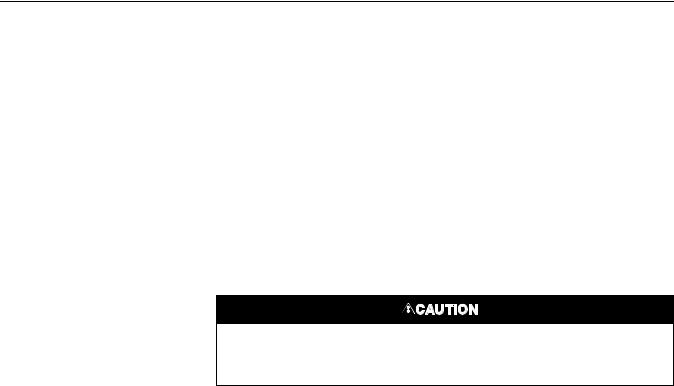
OCX 8800
Instruction Manual
IM-106-880, Rev 1.0
January 2007
PNEUMATIC |
Pneumatic system connections depend on whether reference air set, |
||
INSTALLATION |
calibration solenoids, and/or blowback equipment options are equipped on |
||
|
your transmitter. Refer to the following paragraphs and select the option that |
||
|
applies to your transmitter configuration. |
||
|
Reference Air Set Option (only) |
||
|
When no options or only the reference air set option is equipped, use the |
||
|
following procedure to install the pneumatic system components. |
||
|
1. Refer to Figure 2-5. Connect the reference air set (regulator/filter and |
||
|
pressure gage) to the instrument air inlet on the electronics housing and |
||
|
to the inlet side of the dilution air flow meter. |
||
|
2. Connect the dilution air flow meter output to the dilution air inlet fitting on |
||
|
the sensor housing. |
||
|
3. Install an air line between the instrument air outlet fitting on the |
||
|
electronics housing and the tee fitting on the sensor housing. |
||
|
. |
|
|
|
|
|
|
|
|
|
|
Do not use 100% nitrogen as an O2 low gas. It is suggested that O2 low gas be between 0.4% and 2.0% O2. Do not use gases with hydrocarbon concentrations of more than 40 parts per million. Failure to use proper gases will result in erroneous readings.
4.One CO gas and two O2 gases are used to calibrate the OCX 8800:
CO - 1000 ppm or 4%
O2 low gas - 0.4% O2 high gas - 8%
Connect the output of the test gas sources to the inlet port of the CAL GAS flow meter. Install an air line between the flow meter outlet port and the CAL GAS inlet fitting on the sensor housing.
2-10
